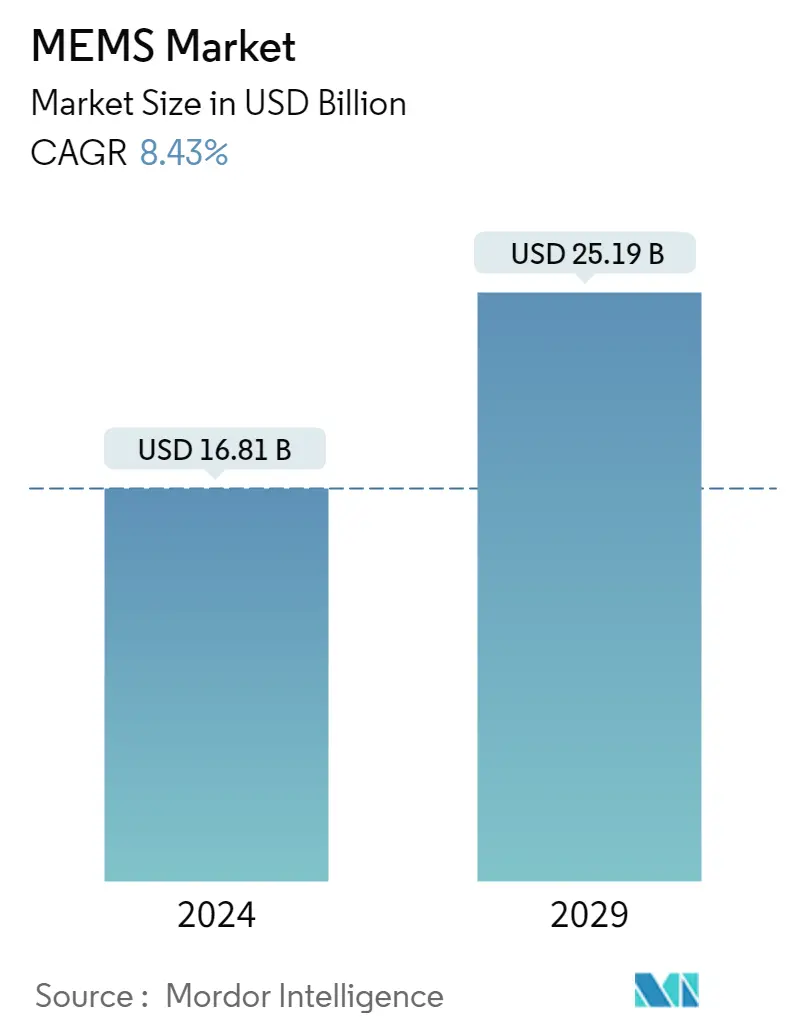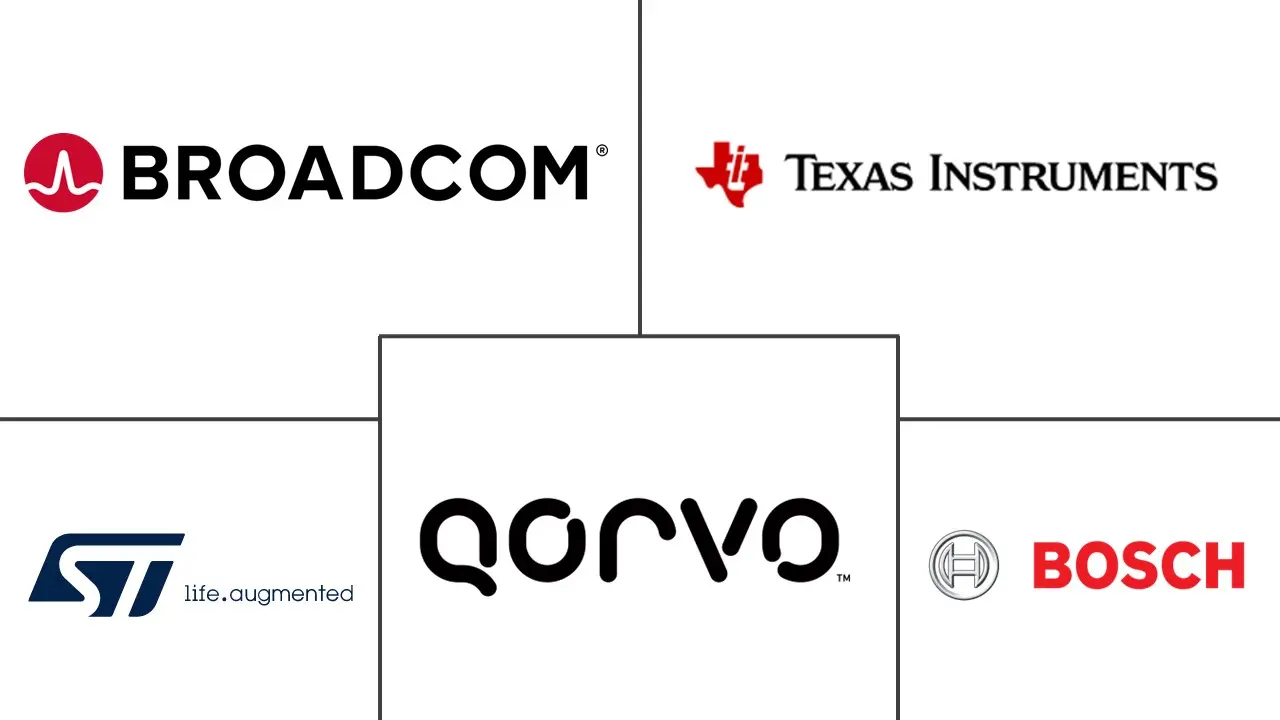Market Size of MEMS Industry

| Study Period | 2019 - 2029 |
| Market Size (2024) | USD 16.81 Billion |
| Market Size (2029) | USD 25.19 Billion |
| CAGR (2024 - 2029) | 8.43 % |
| Fastest Growing Market | Asia Pacific |
| Largest Market | Asia Pacific |
| Market Concentration | Medium |
Major Players
*Disclaimer: Major Players sorted in no particular order |
Micro-Electro-Mechanical System Market Analysis
The MEMS Market size is estimated at USD 16.81 billion in 2024, and is expected to reach USD 25.19 billion by 2029, growing at a CAGR of 8.43% during the forecast period (2024-2029).
The MEMS sector is witnessing rapid growth due to the increasing demand for MEMS in multiple applications, from automotive to consumer electronics.
- Microelectromechanical system (MEMS) sensors have gained significant traction over recent years due to advantages such as accuracy, reliability, and the scope for making smaller electronic devices. Among the significant factors driving the MEMS market are industrial automation and the demand for miniaturized consumer devices, such as wearables and IoT-connected devices.
- The increasing demand for IoT devices worldwide is spearheading the adoption rate of MEMS in these devices; when coupled with the miniaturization trend, the connected devices benefit as well. According to Cisco Systems, the number of connected is expected to reach 1,105 million by 2022, thus driving the market.
- Further, industrial demand for IoT is expected to eclipse the demand for consumer-connected devices over the coming years, with the sheer number of connected devices required and adoption in the industrial space on the rise. By 2025, industrial-connected devices are expected to be more in number than consumer-connected devices, according to GSMA. At CES 2021, TDK Corp. announced the availability of its range of MEMS platforms and sensors for industrial applications.
- However, the market faces challenges in product production and a lack of a standardized fabrication process. Considering the sensor interface design used in the automotive industry, the MEMS produces capacitance changes of tiny magnitudes. This must be addressed with precision and accuracy, increasing the lead time to manufacture the products and slightly offsetting the market's growth.
- Continuous sensorization of both consumer and automotive applications and advances in the medical and industrial end markets and associated applications are important factors contributing to the market growth. Owing to the unprecedented demand for MEMS sensors, many MEMS players are currently investing in new production fabs. For instance, Bosch announced plans to invest more than EUR 400 million (USD 426.07 million) in 2022 in expanding its wafer fabs in Dresden and Reutlingen, Germany, and its semiconductor operations in Penang, Malaysia. As part of the investment, a total of more than 4,000 square meters will be added to the current 35,000 square meters of clean-room space in Reutlingen, in two stages. The first stage, which involved adding 1,000 square meters of production area for 200-millimeter wafers to bring the total to 11,500 square meters, has already been completed.
- In additoin to this, COVID-19 has also accelerated the pace towards a more patient-centric approach and increased the need for remote patient monitoring, including telehealth, point-of-care devices, and wearables. There is a growing demand for wearables owing to their ability to track peoples’ temperature and blood pressure. This trend has created new opportunities in the wearables market, as well as for integrated MEMS sensors, such as pressure, inertial, microphones, thermopiles, etc.
Micro-Electro-Mechanical System Industry Segmentation
Micro-electromechanical systems (MEMS) technology is defined as the miniaturization of mechanical and electromechanical elements, such as devices and structures, manufactured and fabricated using microfabrication techniques. The types of MEMS devices vary from relatively simple structures with no moving elements to structures with multiple moving elements under the control of integrated microelectronics.
The MEMS Market is segmented by type (RF MEMS, oscillators, microfluidics, environmental MEMS, optical MEMS, MEMS microphones, inertial MEMS, pressure MEMS, thermopiles, microbolometers, inkjet heads, accelerometers, and gyroscopes), by application (automotive, healthcare, industrial, consumer electronics, telecom, aerospace, and defense), and by geography (North America, Europe, Asia-Pacific, Latin America, the Middle East, and Africa). The market sizes and forecasts are provided in terms of value in USD for all the segments.
| By Type | |
| RF MEMS | |
| Oscillators | |
| Microfluidics | |
| Environmental MEMS | |
| Optical MEMS | |
| MEMS Microphones | |
| Inertial MEMS | |
| Pressure MEMS | |
| Thermophiles | |
| Microbolometers | |
| Inkjet Heads | |
| Accelerometers | |
| Gyroscopes | |
| Other Types |
| By Application | |
| Automotive | |
| Healthcare | |
| Industrial | |
| Consumer Electronics | |
| Telecom | |
| Aerospace and Defense |
| By Geography | |
| North America | |
| Europe | |
| Asia-Pacific | |
| Latin America | |
| Middle East and Africa |
MEMS Market Size Summary
The MEMS market is experiencing robust growth, driven by the increasing demand for microelectromechanical systems across various applications, including automotive and consumer electronics. The technology's advantages, such as enhanced accuracy, reliability, and the ability to miniaturize electronic devices, are propelling its adoption. The rise of IoT devices and the trend towards miniaturization are significant factors contributing to this growth, with industrial applications expected to surpass consumer-connected devices in the coming years. Despite challenges like production complexities and the need for standardized fabrication processes, the market is buoyed by investments in new production facilities and the continuous sensorization of consumer and automotive applications. The COVID-19 pandemic has further accelerated the demand for MEMS in healthcare-related wearables and remote monitoring devices, creating new opportunities in the market.
Asia Pacific is poised to dominate the MEMS market, supported by the presence of major consumer electronics manufacturers and the region's stronghold in semiconductor manufacturing. Countries like China, South Korea, Japan, and India are key players, with China leading in automotive and IoT investments. The Chinese government's push towards electric vehicles and increased autonomy levels in the automotive sector are expected to drive MEMS demand. The healthcare sector's advancements also contribute to the region's growth. The MEMS market is moderately fragmented, with significant players like Broadcom Inc., Robert Bosch GmBH, and STMicroelectronics NV adopting strategies such as partnerships and acquisitions to enhance their offerings. Recent developments include strategic partnerships and facility expansions aimed at boosting production and supply-chain resilience, further indicating the market's dynamic nature.
MEMS Market Size - Table of Contents
-
1. MARKET INSIGHTS
-
1.1 Market Overview
-
1.2 Industry Attractiveness - Porter's Five Forces Analysis
-
1.2.1 Bargaining Power of Suppliers
-
1.2.2 Bargaining Power of Buyers
-
1.2.3 Threat of New Entrants
-
1.2.4 Threat of Substitute Products
-
1.2.5 Intensity of Competitive Rivalry
-
-
1.3 Industry Value Chain Analysis
-
1.4 Impact of COVID-19 on the Market
-
-
2. MARKET SEGMENTATION
-
2.1 By Type
-
2.1.1 RF MEMS
-
2.1.2 Oscillators
-
2.1.3 Microfluidics
-
2.1.4 Environmental MEMS
-
2.1.5 Optical MEMS
-
2.1.6 MEMS Microphones
-
2.1.7 Inertial MEMS
-
2.1.8 Pressure MEMS
-
2.1.9 Thermophiles
-
2.1.10 Microbolometers
-
2.1.11 Inkjet Heads
-
2.1.12 Accelerometers
-
2.1.13 Gyroscopes
-
2.1.14 Other Types
-
-
2.2 By Application
-
2.2.1 Automotive
-
2.2.2 Healthcare
-
2.2.3 Industrial
-
2.2.4 Consumer Electronics
-
2.2.5 Telecom
-
2.2.6 Aerospace and Defense
-
-
2.3 By Geography
-
2.3.1 North America
-
2.3.2 Europe
-
2.3.3 Asia-Pacific
-
2.3.4 Latin America
-
2.3.5 Middle East and Africa
-
-
MEMS Market Size FAQs
How big is the MEMS Market?
The MEMS Market size is expected to reach USD 16.81 billion in 2024 and grow at a CAGR of 8.43% to reach USD 25.19 billion by 2029.
What is the current MEMS Market size?
In 2024, the MEMS Market size is expected to reach USD 16.81 billion.

